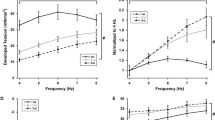Summary
Twitch force and resting tension of electrically stimulated ventricular strips of rainbow trout were compared with tissue contents of phosphocreatine, creatine, and ATP. The phosphocreatine/total creatine ratio, which was used to assess the cytoplasmic phosphorylation potential, fell with the fraction of cell respiration that was inhibited by sodium cyanide and N2. Concomitantly, twitch force decreased while resting tension tended to increase. This relation between phosphocreatine/total creatine and mechanical parameters became more prominent as glycolysis was increasingly inhibited by sodium iodoacetate. Furthermore, glycolytic inhibition was followed by a decrease in the ATP/phosphocreatine ratio. The latter effect was the same in 1% and 6% CO2. Thus, it cannot be ascribed to an action of intracellular pH on the creatine kinase catalyzed reaction. Notably, resting tension as well as twitch force relative to ATP was augmented by glycolytic inhibition. The main conclusions are that in the presence of a decreased mitochondrial activity, glycolysis protects contractility not only by counteracting a lowering in high energy phosphates but also by supporting the ATP/phosphocreatine ratio. Apparently, the creatine kinase activity is insufficient to maintain ATP in equilibrium with phosphocreatine. In addition, glycolysis seems to elevate the level of “free” phosphate relative to ATP, so that twitch force development as well as “rigor” complex formation is counteracted.
Similar content being viewed by others
References
Allen DG, Orchard CH (1983) Intracellular calcium concentration during hypoxia and metabolic inhibition in mammalian ventricular muscle. J Physiol 339:107–122
Allen DG, Morris PG, Orchard CH, Pirolo JS (1985) A nuclear magnetic resonance study of metabolism in the ferret heart during hypoxia and inhibition of glycolysis. J Physiol 361:185–204
Bricknell OL, Opie LH (1978) Effects of substrates on tissue metabolic changes in the isolated rat heart during under-perfusion and of release of lactate dehydrogenase and arrhythmias during re-perfusion. Circ Res 43:102–115
Carlson FD, Siger AJ (1960) The mechanochemistry of muscular contraction. I. The ismometric twitch. J Gen Physiol 44:33–60
Chi MM-Y, Hintz CS, Coyle EF, Martin WH III, Ivy JL, Nemeth PM, Holloszy JO, Lowry OH (1983) Effects of detraining on enzymes of energy metabolism in individual human muscle fibers. Am J Physiol 244: (Cell Physiol 13) C276–C287
Driedzic WR, Sidell BD, Stowe D, Branscombe R (1987) Matching of vertebrate cardiac energy demand to energy metabolism. Am J Physiol 252:R930–937
Eisner DA, Nichols CG, O'Neill SC, Smith GL, Valdeolmillos (1989) The effects of metabolic inhibition on intracellular calcium and pH in isolated rat ventricular cells. J Physiol 411:393–418
Gesser H (1985) Effects of hypoxia and acidosis on fish heart performance. In: Gilles R (ed) Circulation, respiration and metabolism. Springer, Berlin Heidelberg New York, pp 402–411
Gesser H, Jørgensen E (1982) pHi, contractility, and Ca-balance under hypercapnic acidosis in the myocardium of different vertebrate species. J Exp Biol 96:405–412
Gesser H, Poupa O (1975) Lactate as substrate for force development in hearts with different isoenzyme patterns of lactate dehydrogenase. Comp Biochem Physiol 52B:311–313
Giesen J, Kammermeier H (1980) Relationship of phosphorylation potential and oxygen consumption in isolated perfused rat hearts. J Mol Cell Cardiol 12:891–907
Godt RE, Nosek TM (1989) Changes of intracellular milieu with fatigue or hypoxia depress contraction of skinned rabbit skeletal and cardiac muscle. J Physiol 412:155–180
Hasin Y, Barry WH (1984) Myocardial metabolic inhibition and membrane potential, contracture, and potassium uptake. Am J Physiol 247: (Heart Circ Physiol 16) H322-H329
Hibberd MG, Dantzig JA, Trentham DR, Goldman YE (1985) Phosphate release and force generation in skeletal muscle fibers. Science 228:1317–1319
Jacobus WE (1985) Theoretical support for the heart phosphocreatine energy transport shuttle based on the intracellular diffusion limited mobility of ADP. Biochem Biophys Res Commun 133:1035–1041
Kammermeier H, Schmidt P, Jungling E (1982) Free energy change of ATP-hydrolysis: a causal factor of early hypoxic failure of the myocardium? J Mol Cell Cardiol 14:267–277
Kentish JC (1986) The effects of inorganic phosphate and creatine phosphate on force production in skinned muscles from rat ventricle. Academic, New York
Lowry OH, Passonneau JV (1972) A flexible system of enzymatic analysis. Academic, New York
Matthews PM, Bland JL, Gagidian DG, Radda GK (1982) A31P-NMR saturation transfer study of the regulation of creatine kinase in the rat heart. Biochim Biophys Acta 721:312–320
Meyer RA (1988) A linear model of muslce respiration explains monoexponential phosphocreatine changes. Am J Physiol 254: (Cell Physiol 23) C548–C553
Padieu P, Mommaerts WFHM (1960) Creatine phosphoryl transferase and phosphoglyceraldehyde dehydrogenase in iodoacetate poisoned muscle. Biochim Biophys Acta 37:72–77
Paul RJ (1983) Functional compartmentation of oxidative and glycolytic metabolism in vascular smooth muscle. Am J Physiol 244: (Cell Physiol 13) C399–C409
Pirolo JS, Allen DG (1986) Assessment of techniques for preventing glycolysis in cardiac muscle. Cardiovasc Res 20:837–844
Pool PE, Sonnenblick HE (1967) The mechanochemistry of cardiac muscle. I. The isometric contraction. J Gen Physiol 50:951–965
Purup-Hansen S, Gesser H (1987) Extracellular Ca2+, force and energy state in cardiac tissue of rainbow trout. Am J Physiol 253: (Reg Int Comp Physiol 22) R838–R847
Saks VA, Ventura-Clapier R, Huchua ZA, Preobrazhensky AN, Emelin IV (1984) Creatine kinase in regulation of heart function and metabolism. I. Further evidence for compartmentation of adenine nucleotides in cardiac myofibrillar and sarcolemmal coupled ATPase-creatine kinase systems. Biochim Biophys Acta 803:254–264
Smith GL, Allen DG (1988) Effects of metabolic blockade on intracellular calcium concentration in isolated ferret ventricular muscle. Circ Res 62:1223–1236
Veech RH, Lawson JWR, Cornell NW, Krebs HA (1979) Cytosolic phosphorylation potential. J Biol Chem 254:6538–6547
Weiss JN, Lamp ST (1987) Glycolysis preferentially inhibits ATP-sensitive K+-channels in isolated guinea pig cardiac myocytes. Science 238:67–69
Zahler R, Bittl JA, Ingwall JS (1987) Analysis of compartmentation of ATP in skeletal and cardiac muscle using31P nuclear magnetic resonance saturation transfer. Biophys J 51:883–893
Author information
Authors and Affiliations
Rights and permissions
About this article
Cite this article
Hartmund, T., Gesser, H. ATP, creatine phosphate, and mechanical activity in rainbow trout myocardium under inhibition of glycolysis and cell respiration. J Comp Physiol B 160, 691–697 (1991). https://doi.org/10.1007/BF00571269
Accepted:
Issue Date:
DOI: https://doi.org/10.1007/BF00571269




